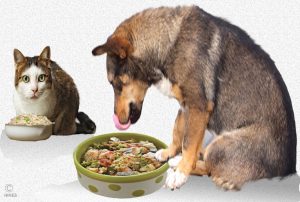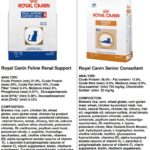My Vet Says My Cat Or Dog Needs A Special Kidney Diet
What Are My Options?
Ron Hines DVM PhD
 Kidney Disease – Its Diagnosis And Treatment
Kidney Disease – Its Diagnosis And Treatment
 The SDMA Kidney Test In Your Dog & Cat – What It Means – What It Doesn’t Mean
The SDMA Kidney Test In Your Dog & Cat – What It Means – What It Doesn’t Mean
If you reached this page from my kidney treatment options page, you already know about the tests and medications that veterinarians use to attempt to slow kidney decline that is so common as our pets get older. If not, you can read about that here.
The medications and lifestyle changes that I mention there all attempt to limit the effects of inflammation, oxidative stress, scarring (fibrosis) and toxins that build up when your dog or cat’s kidneys begin to lose their ability to perform their duties. (read here) We hope that those treatments slow the progress of chronic kidney (renal) disease (CKD). But there are also non-drug options for you to choose from. Many believe that adjusting the nutrient content of your dog or cat’s diet lessens the pet’s kidney work load.
You all know that dogs and cats are carnivores – their teeth and food choices clearly tell you that. Dogs and cats experience great pleasure eating meat, and, given the choice, will consume meat to the exclusion of most of the other ingredients us humans commonly enjoy eating. That’s just fine when they are kittens and puppies and in their healthy adult years. That was what Nature intended. (read here) That is what canine and feline metabolism was designed to thrive on. But when time starts to take its toll on their kidneys, many veterinarians and nutritionists believe these pets might gain a bit more time on this earth if their diet was adjusted to lessen their kidney’s chores. Of course, your pet does not think of it that way, it lives in the here and now and does not contemplate or worry about tomorrow.
Are Cats Different From Dogs In Their Nutritional Needs?
Yes, they are quite different.
Cats have not made the genetic nutritional adjustments to domestication and human diets that many dogs have. Despite what pet food companies stuff into cat food and what owners feed their cats, felines have extraordinarily high protein needs, and they prefer that protein to be meat. Ownerless (feral) cats are free to choose what they can catch and eat. They consume about 52% protein and 46% fat. Only a very small amount is carbohydrate (~2% – most of it coming from eating stored liver and muscle glycogen) present in their prey. (read here) The cat’s normal rodent diet is about 66% water. With such a high protein-rich meat diet, there was no need for them to retain many of the enzyme and metabolic pathways that we omnivores (or even dogs) possess. (read here) The consequence is that felines rely on their prey to furnish many nutrients that us humans and dogs can manufacture in our own bodies. (read here) Another consequence is that one cannot restrict the protein intake or up the carbohydrate intact of cats nearly as much as one can in dogs or humans without causing them great metabolic distress. (read here) You won’t find loose cats eating peas, corn, brown rice, beet pulp, vegetable oil or potatoes in your garden.
Given their druthers, most cats eat about 6 grams of protein per kilogram of their body weight per day. (read here) Earlier studies, used by AAFCO and the NRC underestimated the amount of protein cats needed and what the consequences of not providing it could be. (read here) There is also quite a bit of evidence that cross species lines that otherwise-healthy animals require more, not less, protein as they age. (read here & here) Most healthy adult dogs can thrive on considerably less protein than adult cats. That is because cats must metabolize (“burn”) a great deal of the protein they eat to meet their energy needs. Cats also have problems utilizing energy stores in their liver. (read here) But dogs in their journey to domestication have acquired a much greater ability to digest and utilize carbohydrates. That has led some to suggest that dogs can subsist on diets that have protein levels as low as 16%. (read here) Although the NRC keeps their minimum protein level for dogs at 20% and AAFCO at 22.5% for good measure.
However, dog breeds are quite variable when it comes to their genetic requirements for protein. A few, the “arctic breeds, remain true to wolves in their high-protein requirements. But over canines ~15,000 association with humans, many breeds have mutated from wolves in their diet as well as their temperament. Most breeds now have increased their ability to thrive on the same high-carbohydrate diets that their owners consume. A group of Swedish scientists tried to discover the genetic changes that allow them to do that. They found that dogs had considerably more ability to digest carbohydrates due to gene mutations that increased the levels of their amylase digestive enzymes. Amylase is required for carbohydrate digestion. They also found that their ability to produce amylase varied between breeds. In some dog breeds, the ability to produce amylase was 30 times greater than in wolves. In other breeds, it was only 4 times greater. You can read their report here. In conversations with the authors a number of years ago, they told me that the Arctic breeds, those that might have been domesticated later or exposed to the same highly carnivorous diet that arctic-dwelling humans consume, seemed less able to digest carbohydrates and starches. So, when tinkering with the carbohydrate content of a dog’s special kidney diet, one needs to keep in mind that some dogs are more similar to cats in their lack of ability to digest and utilize starches and sugars.
What Are Veterinary Nutritionists Hoping For When They Suggest That Your Cat or Your Dog Begin A Special Kidney Diet?
Veterinary nutritionists hope that lowering the amount of protein and phosphorus in your pet’s diet will lessen its kidney workload. Both urea and creatinine are formed from the amino acids that are constituents of protein. Although unverified, they hope that additional ingredients like omega-3 fatty acids and antioxidants might reduce kidney inflammation. They hope that reduced salt in your pet’s diet might control blood pressure within the kidneys. (read here) They hope that added vitamins that might be in short supply could also help slow kidney decline (vitamins E and C). The general opinion among veterinarians is that these diets are probably helpful. Although how helpful, at what point you should start and what dose to give your pets is a matter of debate. Other than protein level and phosphorus content where results were contradictory, no further controlled studies have ever been conducted in dogs or cats or even in humans. (read here, here, here & here)
Royal Canin adds marigold and rosemary extracts to their kidney diets – probably because they both contain antioxidants. Purina NF adds garlic oil. Eukanuba adds beet pulp, fructooligosaccharides and gum Arabic probably in the hope that some of the nitrogenous wastes that build up in the blood of uremic pets might instead be excreted in the stool or metabolized by intestinal bacteria. Hills adds beet pulp but no exotic ingredients to their dog and cat kidney care brands. If you believe in alternative medicine, and herbal supplements, I suggest you not give anything in excessive amounts. (read here & here)
Might Lowering My Pet’s Protein Intake Be A Good Idea When CKD Is Present?
Yes
There is no need for your dog or cat’s diet to contain more protein than nutritional guidelines recommend for your pet at its current stage in life (AAFCO and NRC guidelines). Major dog and cat foods sold in stores and online usually exceed those guidelines because of the common belief that “more is better”. A lower protein diet, not a low protein diet is what I suggest. The major brand commercial “prescription kidney health” diets contain enough protein to meet the nutritional needs of your adult cat or dog. They could not sell them if they did not believe that to be so. Homemade diets for cats and dogs are often also considerably higher in protein than non-iditarod cats and dogs require. High meat protein diets are always high in phosphorus as well. (read here) Most veterinary and human nephrologists believe that truly low protein diets are never a good idea until, perhaps, the terminal stages of kidney failure. (read here) But providing dogs and cats that have kidney disease with no more protein than they require to maintain their body weight and general health appears to be a good idea.
The many commercial “kidney health” diets that your veterinarian sells have only moderately reduced protein levels. There are also a lot of smaller players in the veterinary diets market whose products and nutritional adequacy I cannot vouch for. If you elect to give your pet a “kidney health” diet, I believe you will always be safest using a product produced by one of the larger players where board certified veterinary nutritionists and analytical food chemists are making ingredient decisions.
Reading the labeled protein content of your dog or cat’s diet can be deceptive. For instance, a Purina Adult formula dog chow with 21% protein cannot be compared to a Purina NF with Purina NF Kidney Function™ “kidney health” dog chow with a 12% protein level because in that second formula, the protein sources are of much higher and absorbable quality. The same goes for a Hill’s Science diet for cats with a protein level of 35.5% where the chief protein ingredient is chicken compared to a Hill’s® Prescription Diet® k/d® with a protein level of 31.1% where the chief protein ingredient is Corn gluten. The absorbable amount of phosphorus in the gluten meal is considerably less than in the chicken and the protein absorbability and profiles are different.
How Does The Protein My Pet Eats Affect Its Kidneys?
Protein affects your pet’s kidneys in two ways:
First, absorbed protein increases blood pressure within the tiny capillaries that form your pet’s kidney filtering units (the glomeruli). Because this increased pressure causes more blood to be converted into urine through each glomerulus, it is called hyperfiltration. Hyperfiltration is thought to be damaging to the kidneys and one cause of protein leakage into the urine (proteinuria). Early in kidney disease, lower dietary protein levels might keep that pressure in check. But as CKD progresses, your veterinarian might prescribe medications such as ACE inhibitors and/or ARBs to reduce kidney blood pressure and hyperfiltration even more.
The second thing that high dietary protein does is release more metabolic wastes into your pet’s blood stream as protein components are broken down. It is the kidney’s job to filter out those waste products from your pet’s blood stream and deposit them in its urine. Failing kidneys are not good at doing that; so these toxic waste products build up in your pet’s system. But I do not want you to view protein as your pet’s enemy. An adequate amount of protein is essential in your dog or cat’s diet to replenish the amino acid building blocks of its body. Through the early 1980s, human nephrologists believed that truly low protein diets would slow the progress of kidney disease in their patients. But in the late 1980s, NIH began to fund studies to see if that was really the case. (read here) They were called the Modification of Diet in Renal Disease (MDRD) studies. (read here) When the results were finally published in 1994, they had found that there was, perhaps, a slight benefit to the patients eating the lower protein diet in the early stages of CRF. (read here & here) But in the later stages of the disease, patients on a truly low protein diet often did worse than those that ate more protein. Today, we know that older folks may need even higher amounts of protein in their diets than they did when they were younger. (read here) The results of the MDRD studies caused a lot of grumbling in the nephrologist physician ranks. Some agreed, some still don’t.
Is Lowering My Pet’s Phosphorus Intake A Good Idea?
Yes, It is a very good idea.
Veterinary kidney specialists almost unanimously agree that lowering your dog and cat’s phosphorus intake is the prime beneficial effect of “kidney health” diets. Fewer agree that those diets slightly lower protein levels provide substantial benefit. The main dietary source of phosphorus in traditional pet foods is meat. (read here) So when you feed a diet with less protein, you are feeding a diet with less phosphorus as well.
Phosphorus does not float freely in your pet’s blood or body. It is combined with other elements to form phosphates (PO4). Most of the phosphate (~85%) resides in your pet’s bones where it is linked to calcium in the form of hydroxyapatite. Phosphorus is the second most abundant mineral in your pet’s body (calcium at 1-2% is the most abundant). Much smaller amounts of phosphorus are found within all cells of your pet’s body where they are linked to other compounds that are important in maintaining cell structure (phospholipids) and energy production (e.g. ATP). When laboratories report the amount of phosphorus (P) in your pet’s blood, they report it in its pure, uncombined form – not as it actually exists in your pet’s body. Many use the terms phosphorus and phosphate interchangeably.
It is the job of your pet’s kidneys to keep phosphorus levels optimal within the body. When too much phosphorus is present, it is normally excreted into the urine. When P levels are low, most that escapes through the kidney’s glomeruli filters is reabsorbed farther down the line by the cells that form the urine channels (renal tubules). (read here) Dogs and cats on standard pet foods consume many times more phosphorus than they require for their health. So, for most of their lives, their kidneys spend their time removing excess phosphorus.
The situation changes when your pet’s kidneys can no longer remove excess phosphorus efficiently. Abnormally high blood phosphorus levels (hyperphosphatemia) is detrimental in many ways. The most notable effect is on your pet’s parathyroid glands. The parathyroid glands monitor your pet’s blood calcium and phosphorus levels. Excess phosphorus stimulates these glands to release more parathyroid hormone (PTH). That reduces calcium absorption from food, which decreases bone strength throughout the body. Nausea vomiting and lack of appetite that sometimes accompanies high P was thought to be one of the reasons pets with CKD lost weight. But high phosphorus levels might actually directly affect your pet’s muscles in negative ways. (read here) It appears that very small increases in blood phosphorus levels – perhaps even levels in the high “normal” range – can be detrimental over time. (read here)
In 1991, the same Georgia group that did the protein studies in dogs designed an experiment to test the effects of a low-phosphorus diet on kidney failure. Some of the dogs were feed a ~17% protein diet with a standard phosphorus content and the others the same diet with a 70% lower phosphorus content. At the end of 24 months, 75% of the dogs on the low phosphorus diet still survived, but only 33% of those receiving the higher phosphorus level diet were still alive. You can read that article here, or in a second publication which I believe describes the same study here.
Now there are risks in restricting your pet’s phosphorus intake by simply restricting the amount of protein in its diet. Human nephrologists found that out as well. (read here) They call the problem protein-energy wasting. (read here) But there are other approaches to reducing the amount of phosphorus that enters your dog or cat’s body. First, the phosphorus in plant protein is not absorbed from your pet’s intestine as easily as the phosphorus in meat protein. Plant proteins contain compounds called phytates. Some nutritionists consider them antinutrients and urge us to avoid them. But phytates have a good side too. They inhibit the absorption of a lot of the phosphorus that is present in plant protein. Phytates will decrease the absorption of the calcium in your pet’s diet too – so nutritionists suggest that your pet receive a calcium-fortified diet or a calcium supplement. The veterinary nutritionists employed by the major pet food manufacturers know all about phytates. That is why, if you check the ingredients labels on their “kidney health” diets, corn, or wheat gluten meal and/or soybean meal, are high on the protein ingredient list. They also get around these somewhat lower quality protein sources by fortifying the diets with higher “quality” (more digestible and available amino acids) meat and/or egg white ingredients. (read here) One Ohio State veterinarian with an interest in kidney disease estimated that through these manipulations, renal-friendly veterinary diets are able to reduce phosphorus absorption by 70-80% over standard grocery store pet foods. (ask me for Chew 2009) I do not know if that has been confirmed, but renal diets are certainly lower in absorbable phosphorus.
Another Option To Reduce Your Pet’s Phosphorus Intake
The amount of phosphorus that your dog and cat absorb from their diets can also be considerably reduced by giving them the phosphate binders I discussed in my CKD treatment article. (read here) In cats that will accept them, these binders have been reported to be particularly helpful in extending their lives. (read here) Dietary phosphate binders are standard treatment in late-stage human kidney failure as well. (read here) Besides the pharmaceutical binders commonly dispensed, the shells of crabs and shrimp (that contain chitins) seem to have this ability to lessen the absorption of phosphorus as well. (read here) This material is one of the ingredients in Pronefra™, Virbac’s liquid phosphate binder.
What About The Fat Content of My Pet’s Diet?
Dogs and cats are quite good at utilizing fat to meet their energy needs. Whole beef carcasses are about 30-35% fat – although the meat products utilized in over-the-counter pet foods are usually lower. The nutritionists who design the major “kidney health” diets keep the fat content of their products high. That allows them to moderately lower the protein content of the diets while still providing enough caloric energy and taste appeal. Although the makers of these foods say that in multi-pet households, all the dogs and cats can consume the same renal diet, we really do not know what the long-term effect of feeding these diets to healthy dogs and cats might be. Veterinarians know that otherwise-healthy older pets actually need more protein and less caloric fat energy, not the reverse. (read here, here, here & ask me for Finco1999)
That is why I would prefer that you feed these high fat diets to your pets with kidney issues separately from your other pets if that is at all realistic. Feeding these high-caloric diets to normal or early stage CKD pets might also cause a dog or cat owner to mistake an overly chubby pet for one with acceptable lean body mass. That is something you would want to avoid. In laboratory rodents at least, high fat diets are no friend of the kidneys. (read here) But then, rodent were nutritionally designed to eat a diet much lower in fat than cats and dogs were.
When Should My Dog Or A Cat Begin A Lower Protein, Lower Phosphorus Kidney Diet?
I personally would not begin my pet on one of these diets until your veterinarian saw clear evidence that the pet’s kidneys were under stress. Things like beginning elevations of blood creatinine and BUN level (=azotemia), persistently elevated urine albumen protein (microalbuminuria), persistently low urine specific gravity, or elevated blood phosphorus levels. Now there are plenty of veterinarians and naturally all of the manufacturers who will suggest you begin these diets the sooner, the better – even on the basis of the perfidious SDMA test alone. Luckily, the major manufacturers have only modified their recipes in moderate ways. So cats and dogs with healthy kidneys could probably do quite well on them too. Only Purina NF flirts with really low protein levels. But since it is given on the label ingredients as a minimum value (12%) not the maximum level, I really do not know how low its protein content actually is. Dogs and cats get a lot of pleasure from eating meat. It is their natural diet. I would not deprive them of that, particularly when the evidence that it might help their kidneys early in the disease is so meager.
Fed these diets, your pet’s creatinine, BUN and SDMA levels are probably going to go down. But that can be just because the amount of protein they are consuming in those diets is less. It happens in a healthy dogs and cats with no kidney issues when they eat less protein. There is just less protein wastes to dispose of. If these drops have anything to do with positive benefits to your pet’s kidneys is something we do not know. What would warm my heart most would be an increase in your pet’s thin, lean muscle body weight and/or greater playful energy levels.
Is The Omega-3 Fatty Acid Content Of My Pet’s Diet Important? PUFAs
Probably so.
There are two groups of omega fatty acids, Omega-3 and Omega-6. The two of most interest in the Omega-3 group, EPA and DHA, are particularly plentiful in oily fish and krill. Omega-6 fatty acids are particularly plentiful in vegetable oils. A preponderance (more) of Omega-6 fatty acids over Omega-3 fatty acids seems to favor inflammation throughout the body. Several studies in humans suggest that increasing the intake of Omega-3 Fatty acids might slow the progress of CKD. (read here & here) What a proper ratio of Omega-3 to Omega-6 might be is still a matter of conjecture (guess work). (read here) Others were unable to document the benefits of Omega-3 in slowing the progress of CKD in humans. (read here)
EPA and DHA are not part of the normal diet of land-dwelling carnivores like dogs and cats. They get most of their n-3 (omega-3) and n-6 (omega-6) PUFAs in the form of linoleic and alpha-linolenic acid from animal fat – a small amount more from the meat. But that does not mean that EPA and DHA might not be helpful to your pet at certain points in its life. Based on the positive human studies, and the fact that the lower-protein diets used in the Minnesota veterinary school studies were also richer in EPA and DHA omega-3 fatty acids, many veterinary nutritionists suggest that adding larger amounts of these Omega-3 PUFAs than are normally found in supermarket brand pet foods might help slow the progress of CKD. (read here) I tend to agree. Besides, there is little or no downside to giving them to your pet in moderation. Any substance that is active within the body has an effective dose and an excessive dose. If you supplement your pet’s diet with omega-3 fatty acids, give it to them in moderation. Also, you can never be certain of the quality or rancidity of fish oils. When I buy supplements for my pets, I buy those that are intended for human consumption, purchased from vendors that turn their stock over rapidly.
Is The Fiber Content Of My Pet’s Diet Important?
Added dietary fiber might also be helpful for pets with CKD.
When soluble and insoluble fiber reaches your pet’s large intestine, it promotes the growth of certain bacteria. Some of those bacteria can utilize the same waste products (e.g. urea) that your dog or cat’s kidneys can no longer remove efficiently as a bacterial food source. Those waste products come in intimate contact with those bacteria through intestinal blood circulation. That gives some of these wastes an alternative way to leave your pet’s body – in its stool. (read here, here & here)
There are also charcoal-derived products that are added to the diets of humans with CKD in an attempt to sop up uremic toxins. I do not know of them having been used in dogs and cats with CKD. (read here)
Adding To The Acid-Buffering Capacity Of Your Pet’s Diet
Many natural metabolic processes generate acidity. It’s the job of your pet’s kidneys to keep body acidity (=pH) under tight control. It does so by conserving and creating bicarbonate, a buffer, when blood pH becomes too low (acidosis). In pets with advanced CKD, the kidneys often lose their ability to control acidity effectively.
In pets, as in humans, what we eat influences the amount of acidity in our body. (read here) The digestion of dietary protein is a major source of that acid and studies have found that lowering protein intake in humans, laboratory animals and dogs decreases the amount of this acid their bodies must deal with.
Some of the commercial “kidney friendly” diets are formulated with added potassium citrate to reduce the acid load on your pet’s body. In addition to providing fiber, fruits and vegetables are also helpful in reducing body acidity (metabolic acidosis) in humans with kidney disease. (read here) How dietary fruits and vegetables would affect dogs and cats because their digestive system was really not designed to process them is unknown.
Might Extra Vitamins Be Helpful?
Many believe they are – particularly in the later stages of CKD.
First, dogs and cats with reduced appetites are less likely to meet their total vitamin needs. But second, the increased drinking and urination seen in pets with CKD means more of the water-soluble vitamins – B vitamins and vitamin C – are flushed out (lost) through the urine. Older cats in particular seem prone to developing vitamin B-12 deficiencies. (read here) There might also be some connection between low vitamins B intake and elevated SDMA – although not necessarily involving the kidneys. (read here)
What About Antioxidants?
Oxidative damage to cells (oxidative stress) and chronic inflammation go hand in hand and both are thought to play a part in CKD. During normal metabolism, compounds containing oxygen are formed that are highly unstable. They long to combine with (have a high affinity for = oxidize) components of the cells that surround them. (read here) In the process, those cells can be damaged. The body produces its own antioxidants to mitigate that. An important one is glutathione.
Vitamins, like vitamin E (tocopherols), vitamin C (ascorbic acid) and beta-carotene – a precursor of vitamin A, are also antioxidants. Unlike us humans, dogs, and cats can synthesize their own vitamin C in their livers. Fat and organ meat are their natural sources of vitamin E and eating liver supplies them with pre-formed vitamin A. Traditionally, vitamin E and vitamin C have been added to pet foods as a preservative to control the product’s fat content rancidity, extend shelf life and limit fragile ingredient spoilage.
In 2006, Hills Prescription diets ran a study in cats that suggested that a diet enriched with vitamins E, C and beta-carotene antioxidants might protect a pet’s kidneys from oxidative damage. They tested certain white blood cells, lymphocytes, and reported that evidence of DNA damage in those cells was lower in the cats that received the vitamin supplement than in those that didn’t. They also reported that BUN values went down in the cats receiving the supplemented diet. (read here) Based on that report, a lot of folks (all associated in one way or the other with Hills or quoting this 2006 Hill’s-sponsored article) recommended that pets with CKD receive extra E, C and beta-carotene. However, a similar study was performed again with vitamin E by different investigators – this time without Hill’s funding. In that study, vitamin E did not affect their measurements of oxidative stress in cats with CKD. Vitamin E also caused no improvement in the degree of uremic anemia these cats experienced. (read here)
Similar ambiguities (=?s) occur in interpreting the benefits of dietary antioxidants in people with CKD. In a 2014 study, vitamin E and another antioxidant were given to patients with advanced (stage 4) kidney disease. No effects could be found on the marker tests for inflammation in those people, no improvement in anemia occurred, and the patients died at the same rate as those not taking the antioxidants. (read here) An earlier test in patients with less advanced CKD yielded the same negative results. (read here) Another human study with 19,461 participants did find that people who consumed more antioxidant-containing foods in their diet had a bit lower chance of developing CKD. But once a participant on a high or low antioxidant diet had developed CKD, their antioxidant consumption did not influence the rate at which their CKD progressed. (read here) No large reliable studies like those have ever been performed in cats or dogs.
So like the value of omega-3 fatty acids and salt restriction in slowing the progress of CKD in your pet, the actual value of added antioxidants is slippery fish – hard to get a grip on. Everyone, including me, are rooting for antioxidants and omega-3s to give your pet some benefit. When a research study comes up with negative or no positive results one can always rightly argue that the dose was wrong, the mixture was wrong, too much or not enough was given, it was the wrong stage of the disease or the wrong pets were selected for the trial, etc. So with so few proven ways for veterinarians to slow the progress of kidney failure in your cat or dog and so little downside to adding them, there is certainly no harm in seeing to it that vitamin E/tocopherols are an increased component of your pet’s diet – in moderate amounts. I would supply moderately more vitamin E if it was my pet. Just remember that too much vitamin E is toxic. (read here)
L-arginine
The amino acid, l-arginine, is intimately tied to inflammation. In some situations, it produces NO (nitric oxide) which combats inflammation. In other situations, it produces ADMA and SDMA which have the opposite effect. Because some forms of kidney damage are thought to be inflammation-driven, there has been interest in determining if added l-arginine in the diet has positive effects in CKD. (read here, here, here, here & here) Red meat contains large amounts of L-arginine. The highest level I know of is in turkey. An alternative source of an l-arginine precursor is the juice of watermelons. That juice also boosts arginine level in diabetes-prone laboratory rodents. (read here) Not all findings on the effects of l-arginine supplementation in kidney disease were positive. (read here) I do not know of anyone who has examined the effects of arginine supplementation on the kidney disease in dogs or cats. But If you have experience giving it to your pet, please let me know.
Appetite Stimulants
Dogs and cats are pre-programmed to have an affinity for the taste of meat. Picky eating and poor appetite is accentuated during times of stress and disease and kidney disease is no exception. Sometimes, a little love from you and coaxing is all that is required. Sometimes warming your pet’s food helps. In other cases, an aromatic tasty gravy topping does the trick. There are many approaches that don’t require medication. But there will come a time when those techniques will no longer work. In those situations, many vets find mirtazapine (Remeron®/Mirataz®) or Entyce®/ Elura® effective ways to keep your dog or cat eating. Mirtazapine is sold for people as an antidepressant, but it has appetite-stimulating properties as well. (read here) Read about other approaches here.
The newest on the market is Entyce® (capromorelin) and its sister feline preparation, Elura®. These medications are often quite effective with few, if any reported side effects. When reported, I believe that they are due to the bad taste of capromorelin. There was actually one study that appeared to show that treatment with ghrelin, a natural compound with similar effects to capromorelin, helped in reducing weight loss and inflammation in experimental models of kidney failure. (read here) If you use Entyce® in your pet with CKD, I would appreciate your letting me and other readers know the results. I will post those comments here.
Ketoacids
Ten essential amino acids for dogs and cats are arginine, histidine, isoleucine, leucine, lysine, methionine, phenylalanine, threonine, tryptophan, and valine. Cats have an additional requirement for the sulfo-amino acid taurine. Meat protein supplies all of them to your pets. Commercial “kidney health” diets make sure enough of those amino acids are present in their lower-protein diets by using better quality animal and vegetable protein sources.
In the end stage of human kidney disease, when some physicians believe that truly low protein diets might be advisable, some physicians and nutritionists attempt to get around the dangers of low protein consumption by supplementing their patient’s diet with amino acids that have been enzymatically oxidized into keto (C=O) amino acids. In many European and Asian locations, where kidney dialysis and kidney transplants are less available, low protein diets, supplemented with ketoacids, are considered an accepted way to maintain CKD patients and perhaps slow the progress of their kidney failure. The ketoacids products generally used there are Ketosteril® or AlfaKappa®. To the best of my knowledge, neither are sold in North America. I know of no one who has attempted to give them to cats or dogs in an attempt to keep blood uremic toxin levels while on low protein diets. Let me know if you do.
If I Decide To Put My Cat or Dog On A Prepared Kidney Diet, Do You Have A Favorite Brand?
I believe that the major brands, Hills, Purina and Royal Canin, follow similar enough formulas in their renal diets to produce similar results. In choosing one over the other, go with the brand your pet seems to favor. There are other smaller companies marketing similar products. Most have contract packers make the food for them. see here

My personal preference has always been for Royal Canin™. That is not because I know that their current products are any more effective than the others. It is because of my nostalgia for the Waltham Pet Nutrition Centre and the Center’s honest pioneering work on dog nutrition in the 1960s. That was all done long before Big Money entered the picture. Mars Confectionery became the owner of the Centre in the early 1990s – by way of acquiring Royal Canin. (read here) It is also because I hope that they still make fewer unsubstantiated claims for their diets. I have always found the studies Waltham once generated on dog and cat nutrition most credible – both those produced internally and those performed with the collaboration of the Royal Veterinary College, UK, another institution dear to my heart for their honesty and expertise. (read here) Unsubstantiated, crowd-pleasing claims, studies that were poorly designed and manufacturer commissioned and selling points purloined from the popular press never impress me.
Hydration
No matter what diet you choose, I suggest you carefully consider its moisture content. You know from my other articles how important I believe it is that proper hydration is in the prevention of CKD in cats and dogs. I encourage you to purchase either the canned forms of these diets or plan to gradually increase the water content of these dry products. Total daily water intake is considerably greater in cats when they eat canned or moist diets – no matter how many water bowls you set in front of them. (read here & here) I believe that is beneficial to dogs too. I know that adding water or broth to dry diets is messy and inconvenient for you, but I believe that it is very important. Remember that canned products have added jelling agents for owner eye-appeal. So, they look to you like they have less water than they actually do. Most dry foods are 8-10% water. Most canned foods, about 70-80% water. Most natural prey would be 60-70% water. You can do the math to see how much to add. That advice goes for your pets even if you elect to keep them on an over-the-counter senior foods like Royal Canin/Mars’ Royal Canin Senior Consultant, which really are not that different from Royal Canin Feline Renal Support prescription diet. That is particularly true if you add a moderate amount of poultry fat. Similar strategies with closely comparable diets of the same brand can be used when your pet is
a dog. see here
Does My Pet Still Need To Be Monitored By My Veterinarian While On A Kidney Diet?
Yes.
Even if they are not required now, there will be a time when your pet will need medications. If they are required now, there will be a time when their doses need to be adjusted. Veterinarians use the tests I mention in my kidney treatment article and elsewhere on my website (creatinine, urine protein:creatinine ratio, microalbuminuria, BUN, blood albumin and PVC) to monitor your pet’s real-time kidney health. Even those values can vary ~30% from day to day. The most important thing you can do at home is purchase an accurate scale and keep a weight diary for your cat or dog. A stead body weight, or increased weight in underweight pets along with a normal serum albumin protein level suggest that the diet is meeting your pet’s nutritional needs. Some pet owners are not that good at judging their pet’s body weight score or telling when their pet is thin, lean, fat or just right. BCS= body condition scores can help somewhat with that : (read here)
Just because these “kidney health” diets meet the nutritional needs of one pet doesn’t mean it will meet the nutritional needs of another. (read here & here)
Can I Prepare A More “Kidney-Friendly” Diet At Home?
Mr. Van Patten of blessed memory thought so.
I mentioned earlier that one might take a senior dog or cat diet, reduce its protein content with added fat and fortify its vitamin and omega-3 content to produce something quite similar to the commercially available products offered to you. When it is done in moderation, some might attempt to do that alone. But forging your own path is never without risk. It would be reassuring to me to have the helping hand of an experienced animal nutritionist. Many veterinary schools have a board certified nutritionist (= ACVN-Certified) on staff who will do that for you. Many commercial services, staffed by certified animal nutritionists will assist you with that as well.
There are other folks who just derive comfort knowing that the quality of the ingredients they feed their pet are the same quality as the ingredients of the food they eat.
What the optimal diet for dogs and cats with failing kidneys consists of is not yet known. Most agree that lower phosphorus content is likely to be the most helpful. It is unlikely that the most desirable food ingredients will be the same as the ones humans with kidney issues do best one (and even what is best for us is heavily debated).
I mentioned earlier that the phosphorus in plant proteins was less available for absorption than the phosphorus in meat. But even meats differ in their phosphorus content. A good starting point to learn about that are the tables of the ASIA PACIFIC JOURNAL OF CLINICAL NUTRITION.
Some protein-to-phosphorus differences between food sources may not be readily apparent. For instance, egg yolks have 16 times as much phosphorus per gram of protein as do egg whites.
You are on the Vetspace animal health website
Visiting the products that you see displayed on this website help pay the cost of keeping these articles on the Internet.



